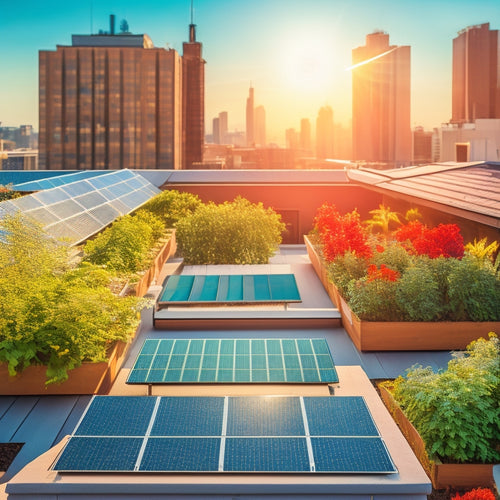
Getting Solar: 3 Essential Steps for Homeowners
Share
As you consider solar energy for your home, you'll need to evaluate your solar readiness by examining your home's suitability, roof size, and energy consumption patterns. Next, choose the right system by understanding grid-tied, off-grid, and hybrid systems, and calculating the total cost of ownership. Finally, plan for a thorough installation process, including evaluating your roof's structural integrity, selecting a high-quality inverter, and scheduling regular maintenance. By following these three essential steps, you'll be well on your way to utilizing the power of the sun - and now it's time to investigate the details that will make your solar expedition a success.
Key Takeaways
- Assess your home's solar readiness by evaluating its solar potential, roof suitability, and energy efficiency to determine if solar is right for you.
- Choose the right solar system by considering system types, cost analysis, and local incentives to ensure it meets your energy needs and budget.
- Ensure a successful installation by planning for a thorough system design, assessing your roof's structural integrity, and selecting a high-quality inverter.
- Regular maintenance is crucial to ensure peak performance, including cleaning, electrical inspections, and energy output monitoring.
- Research and understand the total cost of ownership, including upfront costs, installation fees, and maintenance expenses, to make an informed decision.
Assessing Your Solar Readiness
Determine your solar potential by evaluating your home's suitability for a solar installation.
Start by examining your roof's suitability, considering factors such as size, orientation, and shading. A south-facing roof with minimal shading is ideal, as it receives the most direct sunlight throughout the day. Your roof's material and condition are also important, as some materials may not be compatible with solar panels or may require additional structural support.
Next, evaluate your energy efficiency.
Consider your energy consumption patterns and identify areas for improvement. Upgrading to energy-efficient appliances and lighting can reduce your energy needs, making your solar installation more effective. Additionally, verify your home is well-insulated to minimize heat loss and gain.
Choosing the Right System
Most homeowners contemplating solar have numerous options to choose from, and selecting the right system can be a challenging task.
You'll need to maneuver through various system types, each with its pros and cons. The most common types are grid-tied, off-grid, and hybrid systems. Grid-tied systems are the most popular, as they allow you to sell excess energy back to the grid. Off-grid systems, on the other hand, are ideal for remote areas with no grid connection. Hybrid systems combine the benefits of both.
When choosing a system, a thorough cost analysis is essential.
You'll need to evaluate the upfront cost, installation fees, and ongoing maintenance expenses. Calculate the total cost of ownership, including the system's expected lifespan and energy production.
Additionally, factor in local incentives, tax credits, and rebates that can greatly reduce your expenses. By carefully assessing your options and crunching the numbers, you'll be able to select a system that meets your energy needs and fits your budget.
Installation and Maintenance
As you prepare to bring solar energy into your home, you'll want to carefully plan the installation process to guarantee a seamless and efficient changeover. This involves more than just slapping panels on your roof; it requires a thorough system design that takes into account your energy needs, roof size, and local building codes.
A well-designed system will assure maximum energy output and minimize potential issues down the line.
During installation, your solar provider will handle the heavy lifting, but it's vital to understand the process. They'll assess your roof's structural integrity, install mounting hardware, and connect the panels to an inverter.
Inverter selection is significant, as it converts DC power from the panels to AC power for your home. A high-quality inverter will maximize energy production and provide real-time monitoring capabilities.
Once installed, regular maintenance is important to guarantee your system operates at peak performance. This includes cleaning the panels, inspecting electrical connections, and monitoring energy output.
Frequently Asked Questions
Can I Sell Excess Energy Back to the Grid?
You can sell excess energy back to the grid through net metering benefits, where utilities credit you for surplus power, or energy buyback programs, which purchase excess energy at a predetermined rate, offsetting your electricity bills.
Are There Any Solar Panel Recycling Options Available?
As you gaze up at your newly installed solar panels, you're probably wondering what happens when they reach their 25-30 year lifespan. Coincidentally, solar panel recycling options are emerging, offering responsible disposal and recycling processes that recover precious materials, ensuring a sustainable energy future.
Will Solar Panels Increase My Property Value?
You'll be pleased to know that installing solar panels can enhance your property value, as it's considered a worthwhile upgrade, offsetting the initial solar installation costs and yielding long-term solar investment benefits, ultimately increasing your home's appeal and resale value.
Do Solar Panels Work During Power Outages?
Your solar panels are like a superhero, capturing energy from the sun, but during power outages, they won't save the day unless you have energy storage, which enhances solar panel efficiency, ensuring you stay powered up when the grid goes down.
Are There Any Government Incentives for Solar Energy?
You can benefit from government incentives for solar energy, including federal tax credits that let you claim 26% of installation costs, and state rebates that vary by location, greatly reducing your solar panel investment.
Conclusion
You've taken the leap and gone solar! Now, bask in the glow of renewable energy and the savings that come with it. Like a phoenix rising from the ashes, your home is reborn, powered by clean energy and a reduced carbon footprint. With your new solar system, you're not only saving the planet, but also saving cash on your energy bills. Congratulations, you've taken a bright step towards a sustainable future!
Related Posts
-

Solar System Installation Rebates and Tax Credits
Solar system installations offer beneficial rebates and tax credits that greatly cut your initial costs. You can bene...
-
Trends in Renewable Energy Storage Technologies
You're witnessing rapid advancements in renewable energy storage technologies aimed at improving efficiency and scala...
-

Integrating Smart Technology for Energy Savings
Integrating smart technology into your home is a transformative factor for energy savings. Smart thermostats give you...

